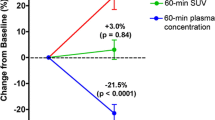Abstract
Positron emission tomography (PET) with 18F-fluoride was utilized to determine the regional blood flow to the femoral head in early osteonecrosis. Five patients with a history of unilateral hip trauma and a normal contralateral side were selected. Skeletal flow and fluoride uptake in the abnormal and normal hips were compared directly, and the relation between bone blood flow and final outcome, i.e., surgical replacement or conservative treatment, was evaluated. In this pilot study, a flow ratio of at least 2 between the abnormal and normal femoral head was necessary to predict a successful outcome with a conservative regimen. A minimum flow of 0.04 ml/min/ ml was measured in one patient whose affected femoral head healed conservatively. Our preliminary study indicates that this type of highly technical investigation appears feasible in clinical practice and permits prediction of the outcome depending upon regional skeletal flow measurements in vivo.
Similar content being viewed by others
Author information
Authors and Affiliations
Additional information
Received: 22 January 1998
Rights and permissions
About this article
Cite this article
Schiepers, C., Broos, P., Miserez, M. et al. Measurement of skeletal flow with positron emission tomography and 18F-fluoride in femoral head osteonecrosis. Arch Orth Traum Surg 118, 131–135 (1998). https://doi.org/10.1007/s004020050332
Issue Date:
DOI: https://doi.org/10.1007/s004020050332




